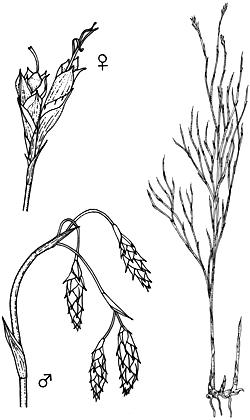Hypolaena fastigiata R.Br. APNI* 
Description: Dioecious perennial herb; rhizome creeping or ascending, ± woolly, with glabrous sheathing scales, 3–4 mm diam.
Culms erect or ascending, mostly branched, straight to slightly flexuous, striate, 20–65 cm high, 1.0–1.3 mm diam., when young minutely white-tomentose, greyish and nearly glabrous at maturity.
Sheaths dark red-brown, striate, closely appressed, up to 1.5 cm long, usually acute, sometimes caudate; lamina reduced to a narrow, flat, fine point, c. 1–3 mm long, erect, often caducous. Male spikelets oblanceolate to elliptic, 5–7 mm long, c. 2.0–2.5 mm diam., dark red-brown, few-many at the end of flowering branches, forming nodding or erect panicles. Male flowers flattened, c. 1.5 mm long: anthers almost sessile, dorsally attached near the base. Female spikelets erect, c. 6–12 mm long, ± elliptic to oblong with spreading apices, dark red-brown. Female flowers c. 1.2 mm long.
Nut ovoid, c. 4 mm long.
Distribution and occurrence: in damp or fairly dry sandy heath and near the margins of swamps; widespread in coastal districts.
NSW subdivisions: NC, CC, SC, CT
Other Australian states: Qld Vic. Tas. W.A. S.A.
Text by A. L. Quirico & B. G. Briggs
Taxon concept: Flora of NSW 4 (1993)
APNI* Provides a link to the Australian Plant Name Index (hosted by the Australian National Botanic Gardens) for comprehensive bibliographic data
***The AVH map option provides a detailed interactive Australia wide distribution map drawn from collections held by all major Australian herbaria participating in the Australian Virtual Herbarium project.
|


